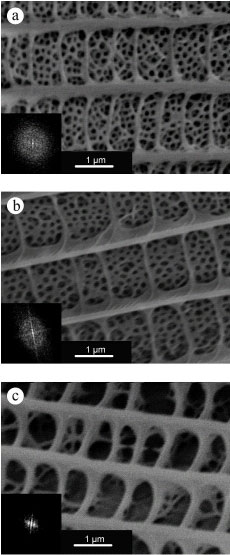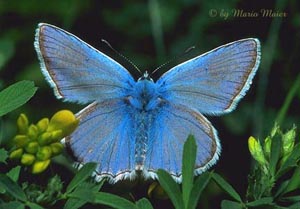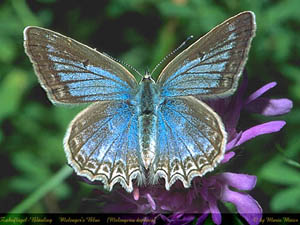| Birds do it, beetles do it, maybe not educated
fleas, but certainly butterflies do it. That is, they use clever
structural engineering in their body parts to produce iridescent
colours without all the fuss of synthesising complex pigment
molecules. Physicists refer to the microscopic features on the
surface of a butterfly's wing, say, as photonic crystals.
Unlike pigments, which absorb or reflect certain frequencies of
light as a result of their chemical composition, photonic crystals
reflect light because of their surface characteristics. The crystal
array may reflect more blue light from one angle than another so the
fluttering of a butterfly or the dash of a kingfisher will produce a
beautiful array of colours.

Butterfly. Source: L. P. Biro et al., Physical Review
E, February 2003
Physicists would like to be able to emulate natural photonic
crystals for their own purposes but could also help biologists
better understand how different species make use of iridescence.
Now, Jean-Pol Vigneron of the University "Notre-Dame de la Paix"
in Namur, Belgium working with colleagues at the Research Institute
for Technical Physics and Materials Science, the Hungarian Natural
History Museum in Budapest and the Department of Applied and
Environmental Chemistry, at the University of Szeged, Hungary, have
discovered why the males in certain populations of lycaenid
butterflies carry a rather striking, photonic crystal colouration,
and males in other lycaenid populations do not. |
The researchers used high-resolution scanning
electron microscopy to take a close look at the wings of the
butterfly popularly known as Meleager's Blue (Meleageria
daphnis; but properly classified as Polyommatus
daphnis) and confirmed that the surface of the wings are coated
with tiny scales pitted with arrays of submicrometre-sized holes,
which form the structure of the natural photonic crystal, and give
the male wing a shimmery blue sheen.

Daphnis. Courtesy of photographer Mario Maier
The wings of the closely related butterfly from higher altitudes
(2000-2500m), the Persian Polyommatus marcidus, however,
lack these holes, and its wings are a dull brown. "The blue colour
can be attributed unambiguously to the fine, sponge-like medium,
called the "pepper-pot structure", present between the ridges and
the cross ribs in the scales of the coloured butterfly. Only traces
of this structure can be found on the scales of the discoloured
butterfly," explain the researchers.
The explanation lies in adaptation of each species to its
environment. At the warmer lower altitudes, the butterfly can afford
to be showy and, adds biologist Zsolt Balint of the Hungarian
Natural History Museum, "Even with their high reflectance they can
control overheating". But, its cousins eking out a living up the
mountain can get warmer in the sun by spreading their dull brown
wings to absorb previous heat. The researchers suggest that the
butterflies at high elevations trade flashy iridescence for
light-absorbing brown so that they can withstand colder temperatures
and garner enough energy during short sunny periods to survive long
enough to mate.

Female P daphnis. Courtesy of photographer Mario
Maier
This temperature effect might be put to good use in novel
clothing materials that have a photonic crystal coat allowing the
wearer to stay cooler in the desert by reflecting heat- inducing
light, but be switched for a non-iridescent form to help absorb heat
in the cold of space, for instance. |



